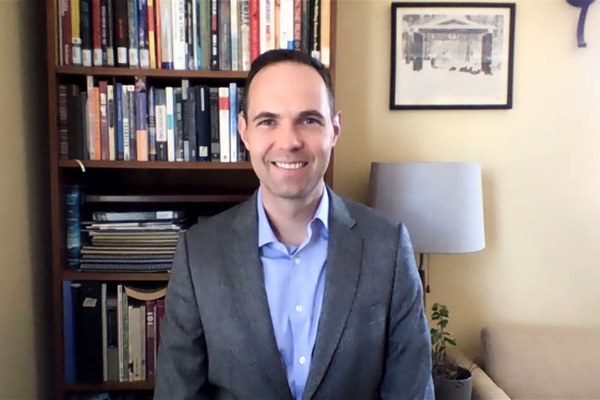Alec Stewart, who received his PhD in architecture from the University of California, Berkeley, is a Mellon fellow in Urban Landscape Studies. His research report, “From Swap Meet to Main Street: Building Multiethnic Commercial Landscapes in Late Twentieth-Century Southern California,” explored the convergence of migrants and international market traditions in 1980s Los Angeles.
Q&A with Alec Stewart
What are indoor swap meets?
Indoor swap meets are a version of the bazaars that have existed around the world for centuries. These indoor market spaces started opening in the 1980s in repurposed warehouses and storefronts across Southern California. While they derive their name from the outdoor swap meets that have operated in parking lots and drive-in movie theaters since the 1930s, they are actually outgrowths of multiple market traditions. In the early 1980s global migration increased, and the demographic composition of Southern California began to change. In response, the Korean investors who opened most of the region’s indoor swap meets integrated aspects of indoor mercados from Latin America and textile markets from Korea into these new emporiums.
Indoor swap meets sell a huge variety of goods, most of which are products of the global industrial economy, ranging from everyday essentials like T-shirts and activewear to auto parts and stereo equipment to nostalgic pieces from around the world. Importantly, these goods have shifted alongside demographics. For example, while many early indoor swap meet vendors initially catered to the tastes of their Black clients, they later sold cooking implements for Mexican cuisine and the cowboy (charrería) attire popular among Southern California’s Mexican diaspora. Latinx patrons have appropriated the markets’ food courts and improvised indoor plazas as vital public spaces in neighborhoods lacking public parks.
What do indoor swap meets tell us about demographic and economic changes in LA in the late twentieth century?
The challenges and possibilities of Southern California’s shifting demographic map came into sharp focus in indoor swap meet spaces. The immigrant influx of the 1980s and 1990s transformed primarily Black neighborhoods in south Los Angeles that were also grappling with the impacts of deindustrialization. As department store retailers closed, these communities were left with very limited retail options. Indoor swap meets, owned and operated in most cases by immigrants from Korea, became surrogates for the retailers that had disappeared. These marketplaces were also public cosmopolitan arenas where an established Black community came into contact with Korean entrepreneurs as well as with Latinx, West Asian, and Middle Eastern vendors, in somewhat superficial ways. They formed opinions about each other in ways that sometimes developed into conflicts that became opportunities for negotiation.
The Rodney King unrest in 1992 illuminated escalating tensions and negotiations about immigrant entrepreneurs, particularly the role of Korean entrepreneurs in historically Black neighborhoods. There was a series of boycotts and protests at indoor swap meets organized by social justice groups focused on winning the opportunity for Black vendors to do business in indoor swap meets because these markets were such important economic and social institutions in their neighborhoods. Ads for vendor opportunities at indoor swap meets, which largely ran in Korean-language newspapers, often referred to Hispanic, Latinx, and Black neighborhoods as ideal places for swap meets because there was a recognition that those were the precise neighborhoods where deindustrialization and economic disinvestment had created business opportunities. The ads offered architectural representations and detailed descriptions about the working conditions, and sometimes included discussions about the race and ethnicity of the customers that fed into preconceived notions. Moreover, many swap meet vendors—due to razor-thin profit margins—were slow to hire employees from nearby communities. These practices were perceived by Black shoppers as economically exploitative, in part because Black customers felt excluded as these opportunities were only advertised to the Korean-speaking community.
Why is it important to study spaces like these?
Often discussions about deindustrialization, globalization, neoliberalism, and postmodernism are really abstract, and when they do focus on built space, it’s often on the macroscopic reconfigurations of the built environment, leaving out the materiality and everyday experience of those spaces. Studying markets like indoor swap meets highlights these phenomena and makes them tangible. These spaces, visible in different forms all over the world, are materially exuberant, and while outsiders might see them as messy, I read them very much as spaces of economic opportunity, resilience, and self-empowerment. In particular, swap meets demonstrate the resilience of the communities that established themselves in south Los Angeles and in so-called “blue-collar suburbs.”
In this extraordinary year, I’ve really appreciated Dumbarton Oaks’ intentionality in creating virtual spaces of congregation over Zoom. In particular, a really nice sense of camaraderie has developed in the Garden and Landscape Studies cohort: [Garden and Landscape Studies Junior Fellow] Liz Wardzinski has created almost daily Zooms where we get together and write, and [Resident Program Director] Thaïsa Way has provided very constructive feedback.
May Wang is postgraduate writing and reporting fellow at Dumbarton Oaks. Photo by Richard Tong, postgraduate digital media fellow.

